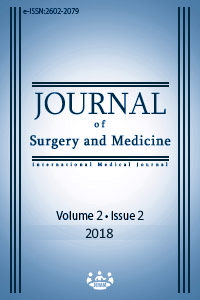The role of lactate clearance on deciding discharge in exacerbation of chronic obstructive pulmonary disease: Retrospective cohort study
Keywords:
Chronic obstructive pulmonary disease, Lactate clearance, PredictionAbstract
Aim: Patients presenting with chronic obstructive pulmonary disease (COPD) exacerbation in crowded emergency departments are often discharged with symptomatic treatment. This situation increases the number of patients admitted to the hospital and the number of attacks. It is very important to be able to predict hospitalization with cheap and easy blood parameters to be looked at the time of application. In our study, we aimed to investigate the relationship between lactate Clearance and admission or discharge decision in patients presenting with acute exacerbation of COPD.
Methods: In this study, patients over 18 years old who were admitted to Batman Regional State Hospital Emergency Department with COPD attack between January 1, 2014 and January 1, 2018 were retrospectively studied. The patients were divided into 2 groups. Group 1 included the patients who discharged after treatment in emergency, group 2 included the patients who hospitalized. Both groups were compared in terms of lactate clearance values.
Results: We studied 117 patients who met the criteria for inclusion in the study. Of these, 65 were discharged and 52 were hospitalized. Six of the hospitalized patients were hospitalized in the intensive care unit. Forty-one patients were female and 76 were male. We did not find any difference between the first and last lactate values of patients who were admitted and discharged (p=0.345 and 0.829). However, the lactate clearances of the discharged patients were higher, while the lactate clearances of patients with hospitalization indications were lower (p<0.001).
Conclusion: We think that lactate clearance can be used as a marker in patients presenting emergency services with COPD exacerbation without deciding on discharge or admission.
Downloads
References
Celi BR, MacNee W. Standarts for the diagnosis and treatment of patients with COPD: a summary of the ATS/ERS position paper. Eur Respir J. 2004;23:932-46.
Chapman KR, Mannino DM, Soriano JB, et al. Epidemiology and cost of chronic obstructive pulmonary disease. Eur Respir J. 2006;27:188-207.
Barnes PJ, Celli BR. Systemic manifestations and comorbidities of COPD. Eur Respir J. 2009;33(5):1165-85.
Tan WC, Lo C, Jong A ve ark. Marijuana and chronic obstructive lung disease: a population-based study. CMAJ. 2009;180:814-820.
Hospers JJ, Postma DS, Rijcken B, Weiss ST, Schouten JP. Histamine airway hyperresponsiveness and mortality from chronic obstructive pulmonary disease: a cohort study. Lancet. 2000;356:1313-7.
Wedzicha JA, Seemungal TA. COPD exacerbations: defining their cause and prevention. Lancet. 2007;370:786-96.
Seemungal TA, Donaldson GC, Paul EA, Bestall JC, Jeffries DJ, Wedzicha JA. Effect of exacerbation on quality of life in patients with chronic obstructive pulmonary disease. Am J Respir Crit Care Med. 1998;157:1418-22.
Global Strategy for the Diagnosis, Management and Prevention of COPD, Global Initiative for Chronic Obstructive Lung Disease (GOLD) 2017 Report. Web site: www.goldcopd.org
Brooks GA. Lactate shuttles in nature. Biochem Soc Trans. 2002;30:258-264.
Philp A, Macdonald AL, Watt PW. Lactate-A signal coordinating cell and systemic function. J Exp Biol. 2005;208:4561-75.
Vernon C, Letourneau JL. Lactic acidosis: Recognition, kinetics, and associated prognosis. Crit Care Clin. 2010;26:255-83.
Levy B, Sadoune LO, Gelot AM, Bollaert PE, Nabet P, Larcan A. Evolution of lactate/pyruvate and arterial ketone body ratios in the early course of catecholamine-treated septic shock. Crit Care Med. 2000;28:114-9.
Revelly JP, Tappy L, Martinez A, et al. Lactate and glucose metabolism in severe sepsis and cardiogenic shock. Crit Care Med. 2005;33:2235–40.
Zhang Z, Xu X. Lactate clearance is a useful biomarker for the prediction of all-cause mortality in critically ill patients: a systematic review and meta-analysis. Crit Care Med. 2014;42:2118-25.
Bernardin G, Pradier C, Tiger F, Deloffre P, Mattei M. Blood pressure and arterial lactate level are early indicators of short-term survival in human septic shock. Intensive Care Med. 1996;22:17–25.
Nguyen HB, Rivers EP, Knoblich BP, et al. Early lactate clearance is associated with improved outcome in severe sepsis and septic shock. Critical Care Med. 2004;32:1637-42.
Cain SM. Oxygen delivery and uptake in dogs during anemic and hypoxic hypoxia. J Appl Physiol Respir Environ Exerc Physiol. 1977;42:228-34.
Downloads
- 2031 2383
Published
Issue
Section
How to Cite
License
Copyright (c) 2018 Nazlı Görmeli Kurt, Murat Orak, Mehmet Üstündağ
This work is licensed under a Creative Commons Attribution-NonCommercial-NoDerivatives 4.0 International License.
















